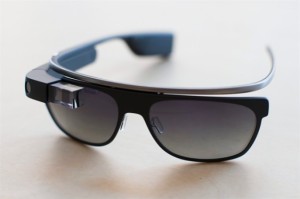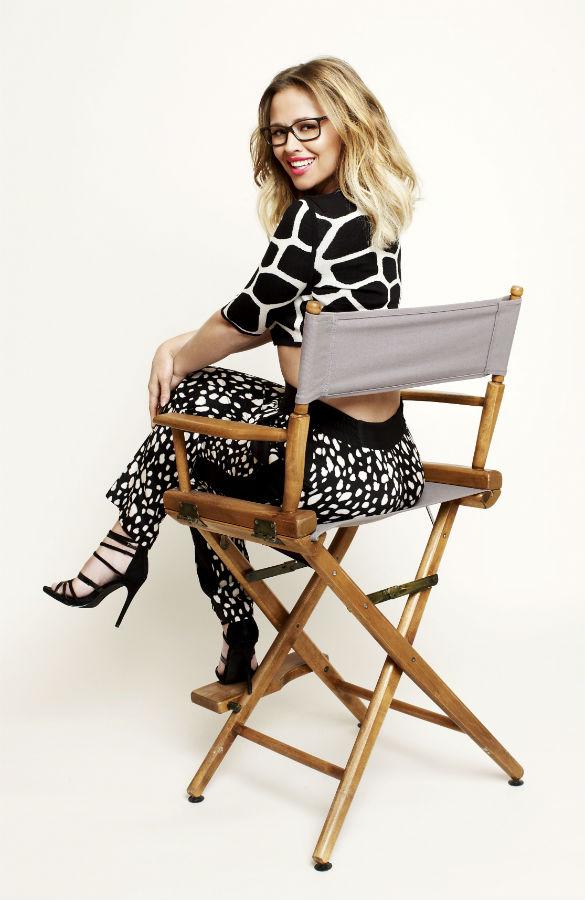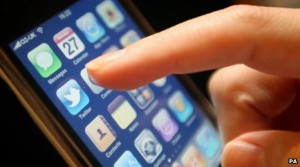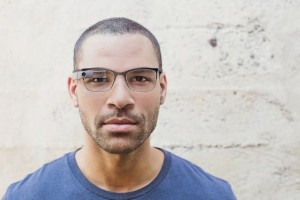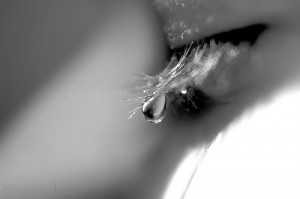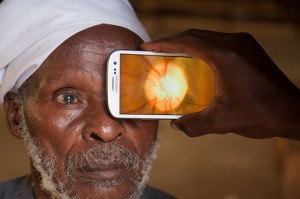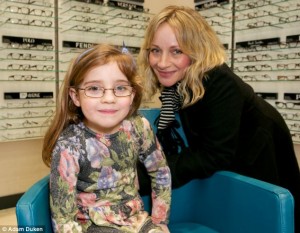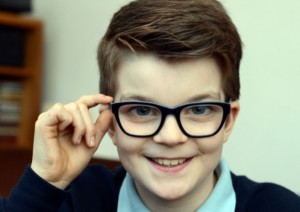
Former Gael flame and aspiring lingerie model Natalie Portman dons some extra nerdy frames while filming in Los Angeles. We’d also be peeved if we had to do that awkward sitting-in-a-skirt-crossed-ankles thing.
The computerized, Internet-connected goggles don’t actually come with lenses in its frame. Starting Tuesday, Google is offering an optional attachment for prescription lenses and new styles of detachable sunglasses.
The move comes as Google Inc. prepares to make Glass available to the general population later this year. Currently, Glass is available only to the tens of thousands of people who are testing and creating apps for it.
Glass is basically a small computer, with a camera and a display screen above the wearer’s right eye. The device sits roughly at eyebrow level, higher than where eyeglasses would go.
It lets wearers surf the Web, ask for directions and take photos or videos. Akin to wearing a smartphone without having to hold it in your hands, Glass also lets people read their email, share photos on Twitter and Facebook, translate phrases while travelling or partake in video chats. Glass follows some basic voice commands, spoken after the words “OK, Glass.”
The gadget itself is not changing with this announcement. Rather, Google plans to make various attachments available for people who wear glasses or sunglasses.
The Mountain View, Calif., company is now offering four styles of frames for prescription lenses. It’s also offering two new types of shades, in addition to the one previously available. The frames cost $225 and the shades, $150. That’s on top of the $1,500 price of Glass.
Girls Aloud singer, Kimberley Walsh now wears her glasses with pride, as the new face of Specsavers’ annual Love Glasses campaign.
Pregnant Kimberley, who showed off some smouldering pictures of her in her specs, said, “I love my glasses, I like to make a real statement by wearing something bold. They are such a part of who you are and a fun way to express yourself. Everyone should wear their specs with pride!
Opticians say people are so addicted to smartphones they may be increasing their risk of eye damage.
They are warning overuse from phones and other devices like computers, tablets, and flat screen TVs can lead to long-term damage.
It comes as a survey of 2,000 people suggests under 25s check their phones thirty-two times a day.
Optician Andy Hepworth said: “Blue violet light is potentially hazardous and toxic to the back of your eyes
“So over a long period of time it can potentially damage your eyes.
“When you’re looking at a smart phone, the light peaking out of that is blue violet.”
He says tests have found that over exposure to blue-violet light has the potential to put us at greater risk of macular degeneration a leading cause of blindness.
Opticians say that, although “good” blue light (blue-turquoise) is needed to help regulate biological clocks, it is also thought that extensive exposure to blue violet light can disrupting sleep patterns and affect moods.
“Although we don’t know if there’s a direct link with it creating eye problems, there is strong lab evidence it can potentially do that,” Andy added.
“It’s the combination of not blinking enough and bringing the device closer than you normally look at objects – it strains your eyes.”
The survey, commissioned by a group of independent opticians, found that on average, an adult spends nearly seven hours a day staring at a screen with nearly half feeling anxious when away from their phone. If you think you or your child may be suffering from symptoms of visual fatigue then you can contact us for help.
In their quest to provide society with technology that can integrate smoothly into one’s social lifestyle (social meaning actual human interaction, not that Twitter fight you’re currently engaged in), Google has managed to catch the attention of a few leading fashion brands.
Google announced a partnership with Luxottica, an eyewear company that owns brands such as Ray-Ban and Oakley, on Monday, March 24.
While users won’t see glass offered on these brands tomorrow, Google notes the partnership as an opportunity to market Glass technology to a wider array of users.
“We see Glass as the next chapter in this long story. Light, simple and modular, Glass introduces new functionality as your glasses get smarter – but bringing your own style to Glass is just as important,” Google wrote in recent post on Glass’s Google+ page.
So not only will Glass be the next smartphone, but the product will also be fashion-ready with frames and shades for chic office wear, hipster weekenders, and all outfits in between.
The Mirror’s Health Columnist Miriam Stoppard, suffers from dry eye and offers some tips on how to make it better.
It’s all down to your tears, which are more complicated than you might think.
Tears normally keep the eyes moist and comfortable and if there aren’t enough tears there’s not only discomfort, but also fluctuation in your vision and blepharitis (redness around the eye margins).
It can be a sign of other health conditions like rheumatoid arthritis (Sjogren’s syndrome).
Dry eye symptoms where the tear film breaks between blinking can also be due to blepharitis and low-grade inflammation.
The tear film covering the eye comprises three layers.
The inner layer is the mucus layer and this allows the watery tears to stick to the surface
of the eye.
The middle layer is the watery layer, which keeps the surface of the eye moist, washing away debris, such as pollen, pollution, bacteria and viruses.
This debris runs into the lacrimal drainage system at the inner corner of the eye and into the nose.
The outer layer is oily and limits evaporation of the watery tears.
Then there are two types of tears. Small glands in the conjunctiva produce watery tears and are stimulated by emotion, creating the tears that flow when we cry.
Eyes that are dry feel gritty, itchy and sore. There may be a heavy feeling and “sleep” in the corner of the eye. Your eyes may be sensitive to light and it may be difficult to open them in the morning. Contact lenses may be difficult to wear and the eyes may be red due to surface irritation.
The eyes may water in the wind due to surface irritation. These reflex tears are watery and don’t wet the surface well.
There’s lots you can do yourself to help dry eyes. Avoid drying at night by humidifying the bedroom and avoid smoke and dust whenever possible. Use artificial tears, especially preservative free and use as often as necessary, especially first thing in the morning and last thing at night
Reduce or avoid contact lens wear or change to a contact lens made of a silicone material and eat lots of fatty fish, nuts and avocados to keep up your omega 3s. Even take an omega 3 supplement.
To find out more about Eye Contact’s Dry Eye Consultation and Treatments go to http://www.eye-contact.co.uk/dry-eye-treatment-dietary-advice/
A new mobile adapter providing a quick, simple and low-cost method in optical care imaging could make today’s smartphone a common diagnostic tool for eye healthcare professionals.
A report in the March 2014 Journal of Mobile Technology reveals the new adapter, which can be easily connected to a smartphone, eliminates the need of the slitlamp technology now used in documenting ocular pathology and imaging of the anterior segment of the eye.
“Think Instagram for the eye,” said one of the developers, Robert Chang, M.D., in an announcement.
The report states the adapter provides “useful clinical information regarding the appearance of the lids and lashes, the clarity of the cornea, the state of the conjunctiva, the shape of the pupil and health of the iris and the presence or absence of a hyphema or hypopyon,” and can be used in emergency triage and teleophthalmology in various settings.
The mobile optical tech advancement comes as healthcare providers, physicians and payers are seeking ways to save costs using emerging technologies and mobile diagnostic tools.
According to the announcement, the initial adapters will be available for purchase for research purposes only while the team seeks guidance from the Food and Drug Administration. The researchers said the production cost is under $90 but the goal is to make it even lower in the future. You can learn more about retinal imaging here http://www.eye-contact.co.uk/retinal-imaging/ or you can contact us.
An actress who appeared on The Bill has told of her shock after her five-year-old daughter was diagnosed with a brain tumour.
Kaye Wragg’s daughter, Matilda, was diagnosed with a plum-sized tumour after a routine trip to the optician.
Ms Wragg, who was PC Diane Noble in The Bill and who will star in Holby City, took her daughter for a routine eye examination in November
Matilda was seen by Manpreet Bahra who was concerned that she was unable to read even the largest letters on the chart despite previously having been able to.
She checked the health of Matilda’s retina and found signs of raised pressure within her brain.
As a result, she referred her to hospital immediately.
‘Had her tumour not been picked up during Matilda’s eye exam, it would definitely have grown bigger, causing her more problems due to the pressure it built up by blocking the flow of spinal fluid through the brain canals. So detecting it through an eye test at was crucial, and we can’t thank the optician enough.’
Retinal Imaging is used by the Optician to check the health of your retina. You can learn more about Retinal Imaging at http://www.eye-contact.co.uk/retinal-imaging/ or you can contact us to book your Retinal Imaging Consultation
When Celine and Ben Jackson bought their son William and his two brothers laser pens for Christmas, they believed they were innocent stocking fillers, the type of toy they had enjoyed playing with safely before.
But on Boxing Day, after using one of the devices, William began to complain of an uncomfortable sensation in his left eye.
The 10-year-old schoolboy, from Wadsley, was checked by an optician and referred to the Royal Hallamshire Hospital, where consultants found inflammation on the macula, the vital central area of the retina at the back of the eye.
William’s eyesight then began to quickly deteriorate, causing his parents to fear he would be completely blinded.
However, the youngster was prescribed steroids which reduced the swelling inside the eye, and now his sight has recovered – but Celine said there is likely to be permanent scarring.
Mr Fahd Quhill, consultant ophthalmic surgeon at the Hallamshire, said: “Misuse of these products can lead to irreversible damage to the eye.
“The retina is very sensitive and once damage is done, it is irreparable. This can impact on children’s futures with normal activities being compromised such as reading, recognition of faces, driving or playing sport.”
Public Health England says lasers sold to the public for use as pointers should generally be restricted to class one or two devices – less than one milliwatt in power.
Mr Quhill added: “One of the laser pointers that caused the retinal damage in one of our child cases was 72mW and all measured were more than 40mW of power and thus Class 3B.”
The research was published in Eye, the journal of the Royal College of Opthalmologists. If you want to discuss the eyesight of your child please contact us.
Wearable devices are already making technology much more intimate than once seemed possible, but Google has kicked it up to a whole new level. The company has announced a project to make a smart contact lens. But this gadget isn’t going to be used to deliver your e-mail straight into your skull — at least not yet. The project is working to tackle one of the biggest health problems facing the country today: diabetes.
The soft contact lens that Google is unveiling — it’s still a prototype — houses a sensor that measures the glucose levels in tears. A tiny pinhole in the lens lets tear fluid seep over the glucose monitor to get regular readings. Right now, the company said, it can get a level reading once every second.The lens also features a tiny antenna, capacitor and controller so that the information gathered from the lens can move from the eye to a device — such as a handheld monitor — where that data can be read and analyzed. It will draw its power from that device and communicate with it using a wireless technology known as RFID.
Given the sensitive nature of the data, Hall said, Google has also said it will make sure any data transferred from the lens cannot be manipulated — something that could have potentially fatal consequences if patients inject the wrong amount of insulin. Google has also worked to build in safeguards against other kinds of problems, such as a piece that is similar to a circuit breaker to prevent the lens from overheating.
- always a great service 10 Dec, 2019
Read more - As usual, a very thorough and efficient consultation. Friendly staff. 10 May, 2019
Read more - “Individual care and attention” 18th June, 2019
Read more - “The service and expertise at Eye Contact is night and day compared to the high street branches advertising on TV.” 18th Jan, 2020
Read more - “Great Service and attention to detail” 17 July, 2019
Read more - I really like the optician that I see and have faith in his skills. 11 August 2019
Read more - Excellent service, proper consultation with plenty of time,to ask questions and consider options 7 September, 2019
Read more - “The staff were extremely helpful, polite and lovely” 5th October, 2019
Read more - “Good professional service and excellent optician.” 5th October, 2019
Read more - “Very thorough and efficient service” 7th October, 2019
Read more - “The service i have received over the last 12 years from Arif and his team has been fantastic. From the level of technical detail and expertise ...
Read more - I have been very happy with the service over many years 12 Oct, 2019
Read more - “Everyone is very friendly, and my glasses are great, so nice to finally be able to see properly!” 18th Oct, 2019
Read more - Friendly staff, efficient service and fair price. 27 Oct 2019
Read more - Exceptionally friendly and helpful staff. 30 Oct, 2019
Read more - “Friendly professional service” 5th November, 2019
Read more - “The staff were extremely helpful, polite and lovely.” 15th November, 2019
Read more - Great personalised service, I now have optimum vision. 30 Nov, 2019
Read more - excellent service and advice. i am a 10-yr customer, 8 Dec, 2019
Read more - “Arif is the most amazing optician” 12 Dec, 2019
Read more - Been using them for years, very personable service. 10 Jan 2020
Read more - I just wanted to send a quick note to thank you again for the great service that you always provide. My company provides free eye tests through its ch...
Read more - Straightforward, friendly and quick service as I transfer to contacts after 12 years of glasses. Arif explained the benefits and I am now enjoying the...
Read more - everything was explained to me thoroughly and I felt more confident with options I would not have chosen in the past. 2 Feb 2020
Read more - “Excellent after-sales service; very friendly and knowledgeable staff” 5th February 2020
Read more - “Love this optician. Always lovely and helpful.” 5th Feb, 2020
Read more - Fantastic service all round from the minute you walk through the door. 9 Feb 2020
Read more - Excellent opticians with excellent service. 20 Feb, 2020
Read more - very good service throughout & went the extra mile to help me. 1 Mar 2020
Read more
Eye Contact, We have moved to,
Salisbury House,
29 Finsbury Circus,
London, EC2M 7AQ
from Unit 2 The Arcade, Liverpool Street, London EC2M 7PN
(t) 0207 626 7232

